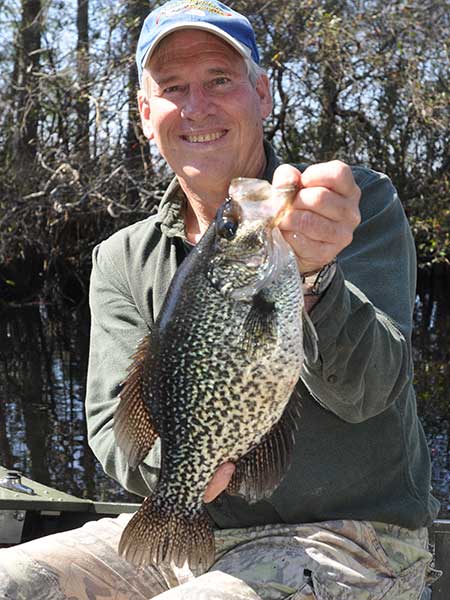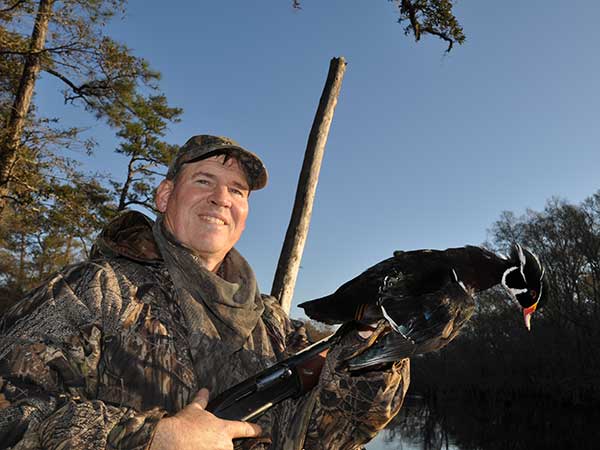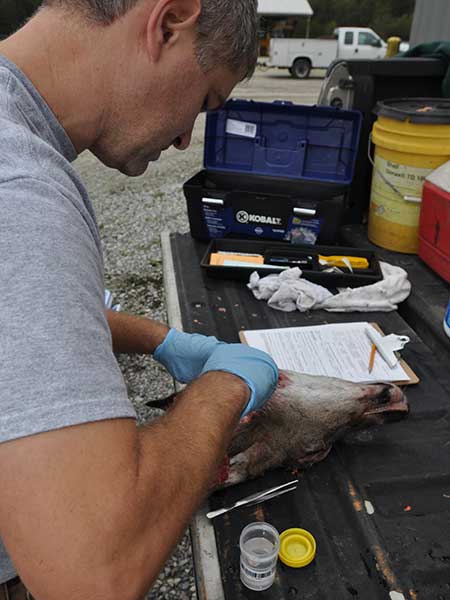- Details
- Written by Mike Marsh
 Everybody brags about catching two-pound crappie. They also talk about all the five-pound speckled trout or six-pound largemouth bass they catch. But, they don't fool me because I know for a fact that fish that large are as scarce as teeth on a turkey's beak. Take crappie, for example. I have caught thousands of them in both their black and white persuasions and may have caught a handful that beefy. However, either I did not have a scale that was accurate enough at the time of the catch, or it was part of a cooler full of fish that included crappie caught by other anglers and I could not be certain one of the honest, two-pounders may have been mine.
Everybody brags about catching two-pound crappie. They also talk about all the five-pound speckled trout or six-pound largemouth bass they catch. But, they don't fool me because I know for a fact that fish that large are as scarce as teeth on a turkey's beak. Take crappie, for example. I have caught thousands of them in both their black and white persuasions and may have caught a handful that beefy. However, either I did not have a scale that was accurate enough at the time of the catch, or it was part of a cooler full of fish that included crappie caught by other anglers and I could not be certain one of the honest, two-pounders may have been mine.
The N.C. Wildlife Resources Commission will issue an angler a North Carolina Angler Recognition Program (NCARP) certificate for a black or white crappie that weighs at least two pounds or measures 16 inches long. The state record black crappie weighed 4 pounds, 15 ounces and was caught by Dean Dixon at Asheboro City Lake No. 4 in 1980. With those statistics as incentive, each spring, I make crappie safaris to fabled waters around the state, hoping to catch one that I can prove weighs enough to earn a NCARP award.
- Details
- Written by Mike Marsh

Fox squirrels have made quite a comeback from 80 years ago when they were so rare they were not legal game. Now legal to hunt in 27 of North Carolina's 100 counties, fox squirrel season may soon be opening in others based on increased sightings in a special deer hunter-observation survey currently underway.
A fox squirrel hunt is a genuine, small-game safari, because it takes place in old-growth forests. These unique habitats include bottomland hardwood floodplains along the coast, oak-hickory forests of the northern mountains and longleaf savannahs throughout the coastal plain. Longleaf restoration areas such as Sandhills, Holly Shelter, Bladen Lakes and Juniper Creek game lands are places where I have hunted them. However, one spot has held me, spellbound, for three seasons.
Read more: Hunt for a White Fox Squirrel is a Lifelong Quest
- Details
- Written by Mike Marsh
 Ending North Carolina's blue law against Sunday hunting has been an uphill fight for years. The statute banning Sunday firearms hunting was enacted in 1868 during Reconstruction. About five years ago, Sunday hunting advocates noticed the law did not specifically ban archery gear for hunting and urged the N.C. Wildlife Resources Commission to allow bow and crossbow hunting. The legislature did not intervene and falconry hunting was eventually included for the same reason. Military bases could already allow Sunday firearms hunting at their discretion.
Ending North Carolina's blue law against Sunday hunting has been an uphill fight for years. The statute banning Sunday firearms hunting was enacted in 1868 during Reconstruction. About five years ago, Sunday hunting advocates noticed the law did not specifically ban archery gear for hunting and urged the N.C. Wildlife Resources Commission to allow bow and crossbow hunting. The legislature did not intervene and falconry hunting was eventually included for the same reason. Military bases could already allow Sunday firearms hunting at their discretion.
In the years since, a hardcore group of hunters never gave up the battle, even with their fellow hunters who disagreed with Sunday hunting. In lengthy, late-night debate on April 28, 2015, the Outdoor Heritage Act, H640, passed the N.C. House with a vote of 83 to 35, just in time to meet a crossover deadline to the Senate.
Primary sponsors were Jimmy Dixon (Wayne, Duplin), Marvin Lucas (Cumberland), Chris Malone (Wake) and Michele Presnell (Haywood Madison, Yancey). The Senate eventually passed a similar version, but with greater restrictions on distances and hours with reference to places of worship. The two branches eventually agreed on a final bill in conference and ratified it on June 29, 2015. Governor Pat McCrory signed the bill into law (S.L 2015-144) on July 8, 2015.
- Details
- Written by Mike Marsh
 Two shooters stood at the ready, hands on the .45s pistols holstered at their hips. Both men drew their guns faster than a desert dust devil. Both bullets struck with a thump, yet neither gunfighter bit the dust. Nevertheless, the winner was determined as instantaneously as he would have been in an old western movie based on the same scenario of a duel in the street at high noon.
Two shooters stood at the ready, hands on the .45s pistols holstered at their hips. Both men drew their guns faster than a desert dust devil. Both bullets struck with a thump, yet neither gunfighter bit the dust. Nevertheless, the winner was determined as instantaneously as he would have been in an old western movie based on the same scenario of a duel in the street at high noon.
The loser was Steve Gregory, whose SASS (Single Action Shooting Society - www.sassnet.com) handle is "Bull." He was shooting it out with the best shooter from the first stage of the competition, Charlie White, alias "Bell Swamp Charlie."
To compete in an event sanctioned by SASS, shooters must wear period garb from the cowboy days of the 1870s, have a Western alias and use only western-style firearms. The only firearms approved for SASS Cowboy Fast Draw shooting events are single action, .45 Long Colt-caliber pistols, either a Colt Model 1873 or a Ruger Vaquero. The holsters have metal deflectors but are otherwise period pieces as well. The deflectors save the gunfighters' lower extremities in the event of an early discharge as they draw their guns and thumb cock the hammer. To further attenuate the risk, rather than shoot a 250-grain lead bullet, their pistols are loaded only with wax bullets and their propellant is a shotgun primer fitted into a specially designed case.
Instead of facing one another down in the street, the gunfighters face a 20-inch diameter round steel target rigged with computer sensors. A randomly timed light switches on, indicating to the competitors that it is time to draw. The fastest bullet reaching the target and keeps the light on. The slower bullet reaching the target a fraction of a second later causes the light to blink. If a bullet misses the target completely, the light goes out.
Read more: Cowboy Fast Draw Match Decides Who is the Fastest Gun in the East
- Details
- Written by Mike Marsh

Scott McLean samples a Pender County deer for Chronic Wasting Disease in October 2013, the last round of CWD testing paid for by hunters through license fees.
The most likely method of the disease entering the state is through an illegal importation of a deer or elk that has not come from a herd certified as disease-free. Are deer wild animals or livestock? Will let your current legislators decide for you?
An article in Great Lakes Echo (http://greatlakesecho.org) shows how far deer farmers will go to earn a buck. It sheds light on why deer hunters must become involved in the legislative process to prevent risking importation of deer with Chronic Wasting Disease.
A lucky traffic stop discovered an illegal shipment of deer heading to Georgia from Ohio that led to 12 charges against a former co-owner of shooting preserves in Ohio and Florida. Donald Wainwright Sr. pleaded guilty to 12 charges and received a 21-month prison sentence and $125,000 fine. Charges against his son, Donald Wainwright Jr. are pending in a plea deal that involves seven others including Ben Chason, partner in Valley View Whitetails and owner of Cherokee Whitetails.
CWD was first found in captive mule deer in Colorado in 1967 and first found in the wild in Colorado elk in 1981. It spread in lockstep with a burgeoning deer farming industry that transported deer primarily so shooters could kill heavy-antlered bucks for high fees. Onerously, CWD-infected wild deer were identified in Virginia in 2010, Iowa in 2014 and Michigan in 2015. So far, biologists have found no CWD-infected deer in North Carolina where hunting deer inside fences is illegal - except on the Cherokee Reservation.
Read more: Senate Bill 513 Turns Wild Whitetails into Livestock
Copyright Notice
Any use of images and/or content of this website without a license agreement issued by Michael S. Marsh is strictly prohibited.
